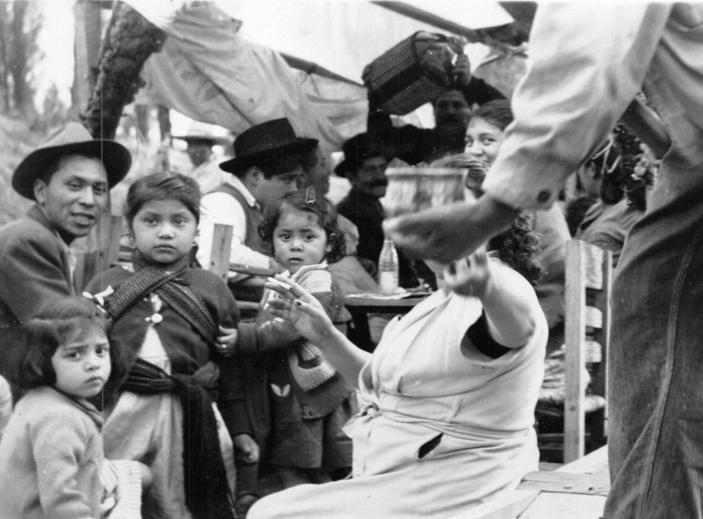
Mexican Families: Mestizo Family--Xochimilco (1945)

Figure 1.--Here we see a Mexican mestizo family having an outing to Xochimilco in 1945. Xochimilco is one of the 16 boroughs within Mexico City. The borough is centered on the formerly independent city of Xochimilco which has been incoporated into Mexico City with its enormous expnsion. Xochimilco was was located on the southern shore of the historic pre-Hispanic Lake Xochimilco. This is a kind of lake in the desert. Xochimilco is all that is left of the five lakes within the Valley of Mexico. It is now a popular park and market. Thus the park and market are a popular place for a family outing.
|
|
Here we see a Mexican mestizo family having an outing to Xochimilco in 1945. Xochimilco is one of the 16 boroughs within Mexico City. The borough is centered on the formerly independent city of Xochimilco which has been incoporated into Mexico City with its enormous expnsion. Xochimilco was located on the southern shore of the historic pre-Hispanic Lake Xochimilco. This is a kind of lake in the desert. Xochimilco is all that is left of the five lakes within the Valley of Mexico. These lakes were the home of many Mesoamerican cultures, including the Teotihuacanos, the Toltecs, and the Aztecs. Xochimilco was a bay in the larger Lake Texcoco on which the Aztec capital was built. The conquest of Mexico was fought on and around the lake. Xochimilco today is an enchanting place of tanqulity, somewhat spoiled by the tourist trade in the middle of a bussling, colossal city. Thus the park and market are a popular place for a family outing. It was made a World Heritage Site (1987). It was known for its colorful flower market. The walled canals are lined with gardens and curtains of trees. Tourists can enjoy a ride the on brightly painted and decorated trajineras ( traditional flat-bottomed boat). This watery surrounding dominated the landscape of the Aztec Anahuac--core of Mexico. Small artificial islands, called chinampas, are used to grow flowers, vegetables, and ornamental plants. The market and park is thus
HBC

Navigate the Boys' Historical Clothing Web Site:
[Return to the Main Mexican family page]
[Return to the Main country family page]
[Introduction]
[Activities]
[Biographies]
[Chronology]
[Clothing styles]
[Countries]
[Bibliographies]
[Contributions]
[FAQs]
[Glosario en Espaņol]
[Images]
[Links]
[Registration]
[Boys' Clothing Home]
Navigate the HBC Mexican pages
[Mexican choirs]
[Mexican Scouts]
[Mexican school uniforms]
[Mexican communions]
Navigate the Boys' Historical Clothing national pages:
[Return to the Main Mexican page]
[Return to the Main Central American page]
[Return to the Main Latin American page]
[Return to the Main countries page]
[Belize]
[Costa Rica]
[Cuba]
[Guatemala]
[Honduras]
[Nicaraga]
[El Salvador]
[Panama]
[United States]
Created: 5:13 AM 4/4/2018
Last updated: 5:13 AM 4/4/2018



